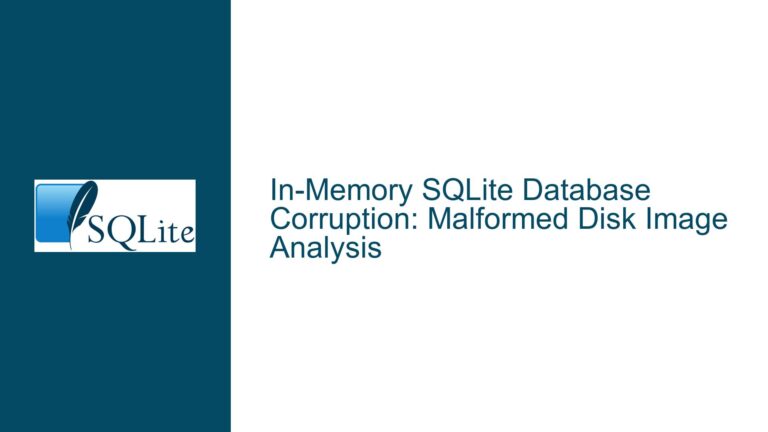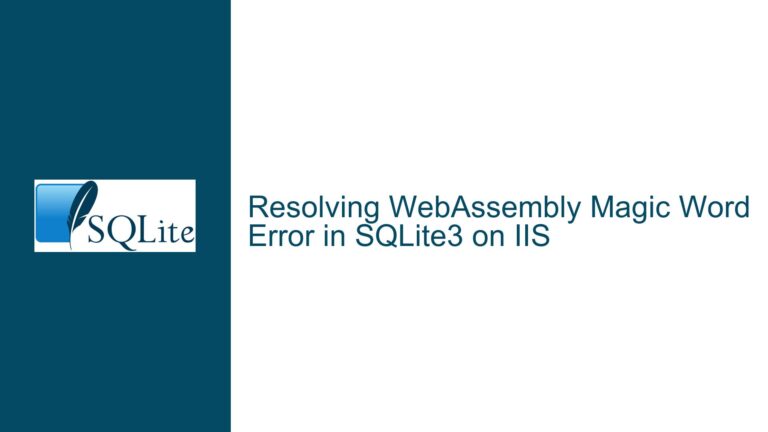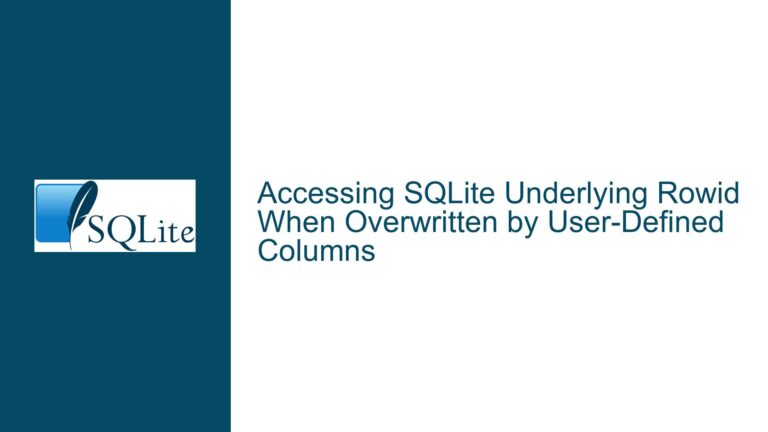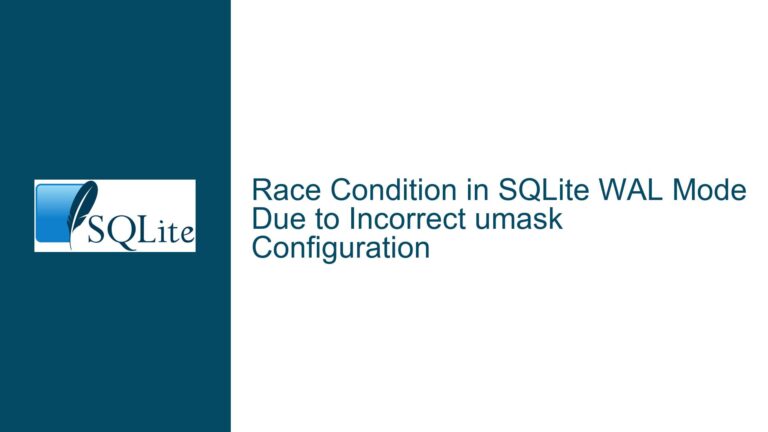In-Memory SQLite Database Save to Disk in PowerShell: Methods & Fixes
Understanding In-Memory Database Persistence Challenges in PowerShell
When working with SQLite databases in PowerShell, developers often utilize in-memory databases for their speed and transient nature. However, persisting an in-memory database to disk presents unique challenges due to SQLite’s architecture and PowerShell’s interaction with database handles. This guide explores the technical nuances of saving an in-memory SQLite database to a physical file, focusing on the methods suggested in community discussions: VACUUM INTO, SQLite Backup API, serialization via sqlite3_serialize(), and the SQLite CLI’s .save command. Each approach has distinct advantages, failure modes, and implementation requirements in PowerShell v5.
Root Causes of In-Memory Database Save Failures
1. Transient Connection Handling in PowerShell
In-memory SQLite databases exist only for the duration of their connection. PowerShell scripts that inadvertently close the database connection before executing a save operation will lose all data. For example, using separate System.Data.SQLite.SQLiteConnection objects for creation and saving creates independent in-memory instances, resulting in empty output files.
2. Incorrect Method Application
The VACUUM INTO command requires write permissions to the target directory and a stable connection. Misusing it as a general-purpose backup tool without understanding its transactional behavior (e.g., failing to wrap it in BEGIN IMMEDIATE transactions) can lead to partial writes or file corruption. Similarly, attempting to use the Backup API without initializing both source (in-memory) and destination (file) databases properly results in silent failures.
3. Environment-Specific Limitations
PowerShell v5’s SQLite module compatibility issues may prevent access to newer SQLite features like VACUUM INTO (introduced in SQLite 3.27.0) or the Backup API. Developers using outdated SQLite binaries bundled with PowerShell modules will encounter "no such table" errors when trying to serialize or back up schemas.
4. File System Permissions and Path Resolution
PowerShell scripts executed in restricted environments (e.g., with constrained language mode) may lack write access to the target directory. Relative path misinterpretations (e.g., using .\data.db vs. absolute paths) further compound this issue.
Implementing and Debugging Save Methods in PowerShell
Method 1: VACUUM INTO with Transaction Control
The VACUUM INTO 'filename.db' command creates a disk database by reconstructing the in-memory database’s schema and data. In PowerShell, this requires maintaining an open connection throughout the operation.
Step-by-Step Implementation
Load SQLite Assembly:
Add-Type -Path "System.Data.SQLite.dll" $conn = New-Object System.Data.SQLite.SQLiteConnection "Data Source=:memory:;Version=3;New=True;" $conn.Open()Create Schema/Data:
$cmd = $conn.CreateCommand() $cmd.CommandText = "CREATE TABLE test (id INTEGER PRIMARY KEY, data TEXT); INSERT INTO test (data) VALUES ('sample');" $cmd.ExecuteNonQuery()Execute
VACUUM INTO:$cmd.CommandText = "VACUUM INTO 'C:\output.db';" $cmd.ExecuteNonQuery()
Common Errors & Fixes
Error: "SQL logic error"
Cause: SQLite version < 3.27.0 lacksVACUUM INTO.
Fix: Update SQLite binaries and ensure PowerShell loads the correct version.Error: "Database is locked"
Cause: Concurrent access to the output file.
Fix: Wrap the command in an immediate transaction:$cmd.CommandText = "BEGIN IMMEDIATE; VACUUM INTO 'C:\output.db'; COMMIT;"
Method 2: SQLite Backup API via .NET
The Backup API allows incremental copying between databases. In PowerShell, this is accessible via System.Data.SQLite.SQLiteBackup.
Implementation
Initialize Source and Destination:
$srcConn = New-Object System.Data.SQLite.SQLiteConnection "Data Source=:memory:;Version=3;" $srcConn.Open() # ... Create schema/data ... $destConn = New-Object System.Data.SQLite.SQLiteConnection "Data Source=C:\output.db;Version=3;" $destConn.Open()Execute Backup:
$backup = $destConn.CreateBackup("main", $srcConn, "main") $backup.Step(-1) # -1 copies all pages $backup.Finish() $destConn.Close()
Common Errors & Fixes
Error: "Source database is empty"
Cause: Schema not created on the source connection.
Fix: Verify schema creation on$srcConnbefore backup.Error: "Access to the path is denied"
Cause: PowerShell execution policy restricts file creation.
Fix: Run PowerShell as administrator or adjust policies:Set-ExecutionPolicy -ExecutionPolicy Bypass -Scope Process
Method 3: CLI .save Command via Shell Integration
Invoking the SQLite CLI’s .save command from PowerShell offers simplicity but requires external process management.
Implementation
Script CLI Commands:
$commands = @" CREATE TABLE cli_table (id INTEGER, content TEXT); INSERT INTO cli_table VALUES (1, 'cli_sample'); .save C:\cli_output.db .quit "@ $commands | Out-File -FilePath "commands.sql" -Encoding ASCIIExecute SQLite3.exe:
Start-Process -FilePath "sqlite3.exe" -ArgumentList ":memory: -init commands.sql" -Wait -NoNewWindow
Common Errors & Fixes
Error: "Invalid command: .save"
Cause: CLI version < 3.31.0 (released 2020-01-27).
Fix: Download the latest SQLite CLI tools.Error: "File not found: commands.sql"
Cause: Incorrect path to the init script.
Fix: Use absolute paths for both the CLI and script file.
Method 4: Serialization via sqlite3_serialize()
Advanced users can serialize the in-memory database to a byte array and write it to disk. This requires P/Invoke in PowerShell.
Implementation
Define Native Functions:
Add-Type @" using System.Runtime.InteropServices; public class Native { [DllImport("sqlite3", CallingConvention = CallingConvention.Cdecl)] public static extern int sqlite3_serialize(IntPtr db, string schema, out long size, int flags); } "@Serialize and Write:
$conn = New-Object System.Data.SQLite.SQLiteConnection "Data Source=:memory:;" $conn.Open() # ... Create data ... $handle = $conn.Handle [long]$size = 0 $ptr = [Native]::sqlite3_serialize($handle.DangerousGetHandle(), "main", [ref]$size, 0) [byte[]]$bytes = New-Object byte[] $size [Runtime.InteropServices.Marshal]::Copy($ptr, $bytes, 0, $size) [IO.File]::WriteAllBytes("C:\serialized.db", $bytes)
Common Errors & Fixes
Error: "DllNotFoundException: sqlite3"
Cause: SQLite native library not inPATH.
Fix: Placesqlite3.dllin the script directory or system32.Error: Incomplete Serialization
Cause: Concurrent writes during serialization.
Fix: Pause all write operations before callingsqlite3_serialize.
Comparative Analysis and Best Practices
Performance Considerations
VACUUM INTO: Full database rewrite; slow for large datasets.- Backup API: Incremental and efficient; suitable for live databases.
- CLI
.save: Simple but incurs process overhead. - Serialization: Fastest but requires native code integration.
Transaction Safety
Always wrap write operations in transactions to prevent partial states. For Backup API, useStep(1)in a loop with error checking for large databases.PowerShell-Specific Tips
- Use
[System.Data.SQLite.SQLiteConnection]::Globalizationto handle path case sensitivity on Unix. - Prefer absolute paths over relative to avoid PowerShell’s working directory ambiguity.
- Validate SQLite version with:
$conn.ServerVersion # Should be >= 3.27.0 for VACUUM INTO
- Use
By methodically applying these solutions and understanding their underlying mechanisms, developers can reliably persist in-memory SQLite databases to disk in PowerShell, avoiding common pitfalls related to connection handling, versioning, and file system interactions.






